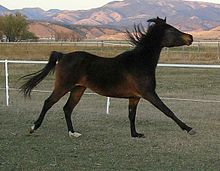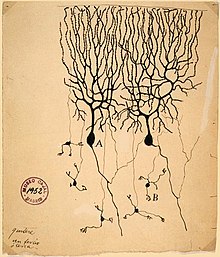Cerebellar abiotrophy
Cerebellar abiotrophy (engl. Cerebellar Abiotrophy , CA), also known as cortical cerebellar abiotrophy (CCA) or cerebellar atrophy refers, is a genetic neurological disease of animals common in certain horses - and breeds occurs. In this disease, the Purkinje cells in the cerebellum die . The disease manifests itself especially in young animals in the form of balance disorders and motor failures.
Affected races
Affected horse breeds are Arabs and their crossbreeds, miniature horses , the Gotland ponies and possibly the Oldenburg . Among domestic dogs, cerebellar abiotrophy occurs primarily in the Gordon setter , wire- haired collie , the Bernese mountain dog , Kerry Blue Terrier and the Brittany Spaniel . Furthermore, takes the disease in Siamese cats , Angus - Polled Hereford - Charolais - and Holstein-Friesian - cattle , Merino - and Wiltshire Horn sheep and Yorkshire pigs on.
Emergence
Cerebellar abiotrophy develops when certain nerve cells in the cerebellum (called Purkinje cells ) die from programmed cell death . The cerebellum controls all movements; the Purkinje cells particularly influence balance , coordination and fine motor skills and enable communication between the different layers of the cerebellar cortex.
In horses, Purkinje cells begin to die in most cases within the first 90 days after birth. The disease can usually be identified when the foal is less than six months old. In some cases, however, the disease progresses so gradually that the owner or carer will not notice a problem until the horse is two or three years old. Most of these cases are noticeable when the withdrawal causes stress, or when the young horse is put into show or further training.
Cerebellar abiotrophy in horses was originally thought to be a form of cerebellar hypoplasia and was referred to as such in older scientific literature. There are diseases that cause other forms of cerebellar degeneration, but the loss of Purkinje cells is a clear indication of cerebellar abiotrophy.
Clinical signs (symptoms)
- Uncontrollable movements (ataxia) or balance disorders,
- awkwardly wide forelegs with fetlock joints close together ,
- tremor of the head (intention tremor),
- Hyperactivity,
- lack of threat reflex
- third eyelid ( nictitating membrane ) shows delayed or no blinking,
- stiff or excessive gait from the shoulder to the forehand,
- rough or jerky head jerking when moving or when trying to suckle in very young animals,
- Standing on bent hooves or trying to walk like this, sometimes with crossed legs,
- poor depth perception and general inability to judge space and distance.
In more severe cases, foals / horses may have difficulty getting up or pointing straight backwards. Tight turns can cause hind legs to fall or slide sideways. Affected horses are prone to accidents, tend to run into stationary objects, fall sideways when climbing, and often hit their heads, which can erroneously lead to the impression that a severe head injury caused the ataxia . The affected horse has normal intelligence, clear vision, a good appetite and does not show muscle atrophy .
Affected dogs are completely normal at birth. Only after months or even years do movement disorders gradually develop, namely when a corresponding number of Purkinje cells have died.
Inheritance
In horses, cerebellar abiotrophy is inherited as a monogenic autosomal recessive trait. Horses that carry only one copy of the gene can pass it on to their offspring, but they themselves are without any clinical signs of the disease.
research
The genetic basis of CA is currently being studied at the University of California, Davis Veterinary Genetics Laboratory . While the specific mutation causing CA is still unknown, a group of contiguous genetic markers has been identified that can be used as a DNA test for CA. Breeders who want to test their horses before mating can use the CA test to avoid pairing two carriers.
Results of the test are displayed as follows:
- N / N: normal. Horse has no markers associated with CA.
- N / CA: carrier (1 copy of the CA allele). Horse has markers associated with CA and is considered phenotypically normal and a carrier of the disease allele.
- CA / CA: affected (2 copies of the CA allele).
See also
Web links
- Testing (UC Davis, English)
- Video of a two year old horse with CA
literature
- H. Gerber et al .: Cerebellar abiotrophy in thoroughbred Arabian foals In: Pferdeheilkunde 11 (1995), pp. 423-443.
- Apoptosis of Purkinje cells in three Arabs with cerebellar abiotrophy
- A. Blanco et al .: Purkinje cell apoptosis in arabian horses with cerebellar abiotrophy. In: J Vet Med A Physiol Pathol Clin Med 53 (2006), pp. 286-287. doi : 10.1111 / j.1439-0442.2006.00836.x
- D. Böhm et al .: Differential diagnosis of cerebellar and spinal ataxia in horse. A case of cerebellar ataxia in a foal. Berl Münch Tierärztl Wochenschr 88 (1975), pp. 81-86. PMID 1120060
- WAHO. Genetic Diseases in Arabian Horses: Current Research Projects. World Arabian Horse Association, accessed online October 23, 2007
- A. de Lahunta: Abiotrophy in domestic animals: a review. In: Can J Vet Res 54 (1990), pp. 65-76, PMC 1255608 (free full text).
- Sigitas Cizinauskas and André Jaggy: Cerebellar Atrophy . In: Andre Jaggy: Atlas and textbook of small animal neurology. Schlütersche 2005, pp. 356-357. ISBN 3-87706-739-5

